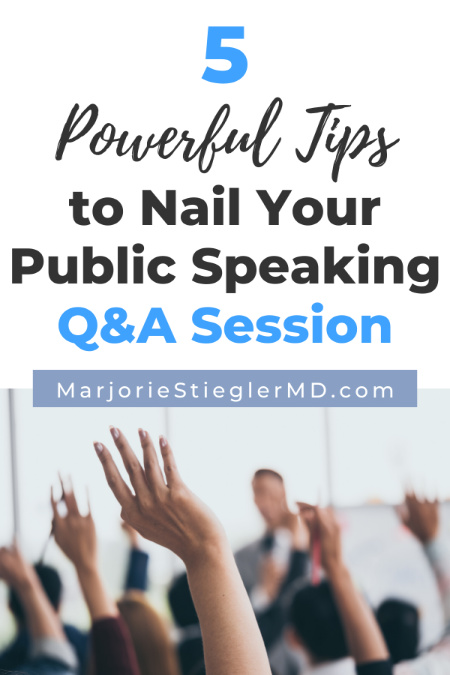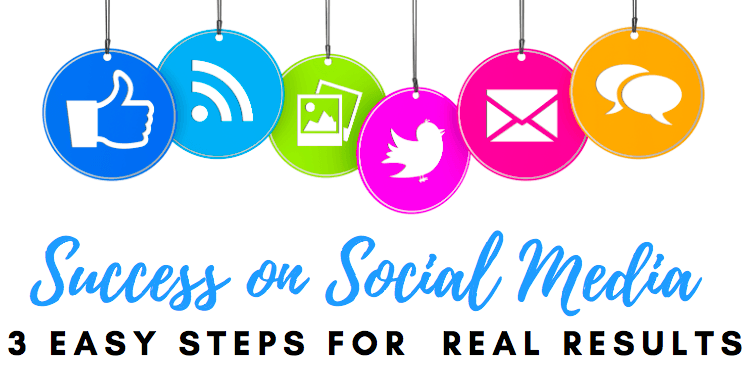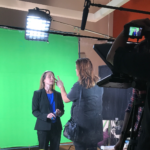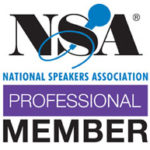
On the podcast today, I’m giving you a behind-the-scenes peek at a Q&A session bonus training that I recorded today for The Speaking Prescription.
I’m doing two things at once, sharing some tips here on the podcast and also putting together this special training.
Some of you are familiar with my course – The Speaking Prescription, but for those who aren’t let me tell you a little about it…
The Speaking Prescription is a 12-week course that focuses on the business of professional public speaking. It helps you secure high paid, career-boosting, high profile speaking engagements. This will help advance your academic career, your career in the private sector, your entrepreneurial career and your career as a thought leader.
I’ve put together this bonus training for my students in the course. It’s going to include 5 tips to really rock the Q&A session of any type of speaking engagement. This often – and for good reason – really scares people much more than the main presentation.
Today, in the podcast, I’m going to share 5 of these tips for all of you listening!
In This Episode of The Career Rx We’ll Discuss:
- How to conquer your fears about the Q&A part of any public speaking engagement
- How to prepare for the ‘unknown’ and handle public speaking Q&A with confidence
- Powerful ways to use time, body language, and grace to handle even the toughest public speaking Q&A situations
LISTEN TO THIS EPISODE:
SUBSCRIBE TO THE CAREER RX PODCAST:
Want to get access to the latest podcast? Subscribe on your preferred podcast player…
Apple Podcast | Google Podcast | Spotify | TuneIn + Alexa | iHeart Radio
TRANSCRIPT AND SHOW NOTES
Hey there friends! Welcome to The Career Prescription podcast (aka The Career Rx). I’m your host Marjorie Stiegler.
Today I’m sharing these 5 tips to nail your Q&A session in all types of public speaking presentations.
As mentioned this content is from the bonus training in my course – The Speaking Prescription.
I really wanted to share some of these powerful tips with you here on the podcast. This is so my listeners can get some great speaking tips for managing and mastering their question and answer session, plus this content will give you a flavor of The Speaking Prescription course.
So, today I’m sharing 5 of the 10 Q&A tips right here on the podcast.
Many speakers fear the Q&A part of a presentation.
Q&A is that uncontrolled, unstructured time at the end of a presentation, so there’s not the same ability to rehearse and to get things polished for the Q&A, or at least that’s how people feel.
So, I’m here to share with you some of the tips that you can practice. This will help you feel more confident and have better responses in the moment. These tips will also help you manage tricky situations which are more about managing your audience rather than managing your own mastery of the content.
5 Tips for Improving Your Public Speaking Q&A Session
I’m going to read them to you today. This is what we’re going to cover.
- How to prepare.
- The importance of reframing the experience.
- Elegant ways to buy yourself some time.
- How to deal with the question that’s not a question. I think you know what I mean with that one!
- The “over the head” technique.
There are 5 additional tips that are included in the bonus training from The Speaking Prescription course…
- The importance of having curiosity and crowdsourcing from the mic.
- What to do when you don’t know the answer.
- How do you use those followup questions very strategically?
- How to manage controversy. Or frankly, if the person asking the question is just flat out incorrect about what they’re saying. So how to manage controversy and factual mistakes with grace.
- How to use your time off stage to manage and optimize your time on stage, plus the way you come across on stage with your responses.
Let’s get into it!
Related: 10 Pro Tips to Improve Your Public Speaking Skills
1. The Importance of Preparing for Your Q&A Session
Many people feel like you can’t really prepare for Q&A, but this is simply not true.
I have 3 helpful tips you can use to prepare.
First, prepare by sitting down and brainstorming the various types of questions you’d expect.
Try putting yourself in the shoes of someone who doesn’t have any familiarity with your subject matter or someone who does and is really, really interested.
You might want to do this twice.
- One from the lens of someone who doesn’t know anything. What might they be asking, what might they need clarity on?
- Then from the lens of someone who’s really into this topic. What they might think is most interesting, most exciting, what do they really want to know?
Those are two ways that you can brainstorm and prepare for some questions.
Second, practice your questions and answers with other people.
Ask them to come up with some tough questions for you even if they know the answers.
Third, keep notes for future Q&A sessions – or to add to your presentation.
Every time you give a presentation you should be recording and jotting down the kinds of things that people ask you.
This is really helpful because over time if people are asking the same things, that’s great market research.
This shows what people care about. They want to know the answer and you can start to build it into your talk if you wish in order to answer that question before the Q&A. It can be part of your presentation.
As an alternative, if you know a specific question always comes up and it’s a question that you love to answer because you really feel like it adds value, then you can just leave it knowing that it’s likely to come up.
2. Reframing the Q&A Session Experience
Many people are afraid of Q&A because of that lack of control. There can be a feeling as some kind of attack; it’s some kind of threat to you.
So, of course, it triggers your sympathetic nervous system and you get that fight or flight feeling. You often have your mind go blank when you’re in that kind of situation.
However, it’s important to reframe this. I’m not talking about thinking positively, but to truly make a deliberate effort to think differently about the Q&A part of the presentation.
If nobody puts their hands up, stands up and goes to the mic, that would be a big disappointment. That would really mean that your presentation fell kind of flat. I think you would interpret people lining up at that microphone or putting their hands up that your topic is important, that people are engaged and interested.
So what I recommend is that you actually take the effort to reframe this.
What do I mean?
Every time you think about your talk or when you’re preparing, I want you to say (literally out loud) that…
- Q&A means that people are interested.
- Q&A means my work matters.
- When people are asking questions this means that my topic is important.
Create some sort of sentence like that feels right to you.
I would love it if you would start to say that out loud in the moment.
When you start to have those panics while you’re practicing and when you’re on stage, you can pull those positive Q&A thoughts out of your pocket.
If you do this on a regular basis I really think you’ll start to feel less anxiety about your Q&A. You will have changed the way that you view it and you’ll have so much success by deploying this and other tips that you’ll have a really good QA experience.
When you have that, then you will feel like you’re looking forward to the Q&A. It will feel like that time to really get into the stuff that matters most to people.
3. Elegant Ways to Buy Yourself Some Time on Stage During Your Q&A
I want to segue directly from tip #2 into tip #3 because you can use the same language/technique.
While you’re practicing and you get panicked about Q&A, and I’m asking you to say out loud, something like… questions mean my topic is important. Questions mean my audience is engaged.
When you’re on stage, it’s time for Q&A and someone asks a question, you can begin by thanking them, reaffirming the importance of the question and how delighted you are that they have it because it means they’re really engaged.
So you can say this out loud…
Thank you so much. That’s a really important question. I’m so glad to know it’s of interest to you or I’m so glad to see that you’re engaged about this.
Just saying that sentence does a few things
It puts you on the same page & gives you a moment to think.
You’re welcoming the question, you’re not defensive and even if you don’t know the answer or the question itself seems to be a challenge, what you’ve done is respond in a positive way that brings everyone together.
So that’s helpful just for setting the tone and what it also does is it gives you a moment to think. It gives you some time to respond.
Begin with a thank you to them and by reaffirming how important it is, how much you appreciate or that they’re engaged. Now you’ve just deliberately with a little bit of effort said out loud from the stage what your new mental frame is.
So that’s really super and it has bought you a few seconds of time to think, to begin to get your thoughts together.
Part two of that is to repeat or rephrase what the person has said. This is pretty common advice.
You do want to keep this in mind because not everybody in the audience may have heard the person with the question. That can often happen with various audio situations. So you want to be sure to repeat the question.
The other thing is sometimes people are pretty verbose when they’re asking a question and you want to give a succinct tee up of what it is that you are about to answer. This is your understanding of the question in a short way so that everybody else is oriented to what you are about to say.
This is also a helpful tip if the person has asked eight questions in a row and you are going to be answering one of them.
So thank them, rephrase or repeat what they have asked and then answer that question in a short and concise way.
4. How to Handle a Question That’s Not Really a Question.
Particularly in academics, I think this is a very common experience that someone takes the microphone and they don’t really have a question. They want to make you aware of their own work or they want to point out something that they feel you left out that was important.
Sometimes it’s sort of nefarious. They either want to make themselves sound really smart or they want to make you somehow look dumb. I think oftentimes they really just want to be heard.
So this, of course, is not going to be happening in certain types of speaking venues. It’s not gonna be happening after your Ted talk. It’s not going to be happening after your commencement address, after your motivational speech or your workshop.
Very often when you give that academic talk, during your Q&A session somebody else in the audience who feels they are also an expert, just wants to share what they know and it’s not really a question.
So they’ll take the microphone and they’ll take some time and they’ll continue to go on.
This is one of the things that rising academic stars really fear because they do have respect and deference for the fact that there are other experts around.
You can hold your own power as your own expert or your own level of expertise is not diminished because somebody else in the audience has something else they want to add.
Oftentimes it’s tangentially related anyway. The main point is they take the microphone and they really are not asking you a question.
How do you respond to this?
Generally speaking, you want to manage your Q&A session time.
This is important as the audience doesn’t love when someone else is talking about stuff that isn’t really related.
On a case by case basis, decide if this ‘non-question’ is relevant.
Maybe you do want to probe more, but if you feel like it’s not relevant and it’s just going on, I would say simply thank this person and say this is important information. It’s obviously outside of the scope of this presentation, but really great to know and then move on.
That I think is a perfectly reasonable way to acknowledge and thank the person because really they want to be heard.
There’s no sort of winning in this case. I don’t think it’s appropriate to say, you know, you’re right, I forgot to mention that. If you’ve been practicing and preparing, you really didn’t forget this information, it’s just outside the scope.
If you have planned your presentation well and you were not intending to cover that, then you are not intending to cover that. So it’s outside the scope of your presentation.
So instead of saying, I forgot, or thanks for pointing that out, I’ll add it in next time or anything that really frames up your presentation as somehow lacking, I would instead just focus on thanking them.
This is important and great to know and, and outside the scope of the presentation.
I’m a fan of using the word and instead of but because, but sort of undoes it.
If you say that’s really great to know, super important, but it’s outside the scope of this conversation in a way that could be received negatively – as if you’re saying, you know, you’re, wasting air time here.
So when you use and it may soften that delivery and keep everybody feeling like there’s no friction and thank you so much for sharing that. “It’s really great to know it is outside the scope of this presentation, so thank you for adding it now.”
This is how to handle a question that’s not actually a question.
Now, what if that really persists? This leads us to the next tip…
5. Use The Over The Head Technique in your Q&A Session
We’ve always had that person, either the person who’s questioned is not a question or the person with five or six questions that are going to just monopolize the mic and not give other people a chance.
What do we do with that person? This is a sticky situation.
It can be really tricky to manage in an elegant way and I like to use what I call the over the head technique.
So the over the head technique means that you are literally going to look over their head or beyond their head to the next person.
I’m assuming you’ve taken a moment to professionally engage with them in one of the ways we’ve talked about… Thanking them for their question, mentioning either that the question is outside the scope or answering that first question.
However, if somebody persists in a long-winded discussion or they have many follow-ups, then you want to say in a professional way that you want to be sure to other people and you are happy to discuss it more after your presentation.
Then take that moment to literally move your head away from their eyes to someone else.
If you have a room that has two mikes, this is especially helpful for those bigger audiences as you can turn your entire body and your gaze to the other side of the room. This very clearly says it’s the next person’s turn. Now you can even gesture at them to go ahead.
If you just have one mic and you just have one line of people, then you have to look over their head.
For the over the head technique, it’s really important you do the following:
- Answer their question.
- Give a response.
- Say you’re happy to discuss offline.
- Make it clear you want to have time for other people to participate.
- Move your eyes away.
Don’t wait for them to acknowledge and say, okay, although they might. They most likely will say thank you and step away, which is great. If they do not, the way you can overcome this is by just moving your eyes to the next person gesturing with eye contact to go ahead.
This is important not only for you and whether or not you’re comfortable.
It’s a value add to the audience as they don’t want to have their precious time taken up by someone else whose main goal is to talk about other things outside the scope of your presentation.
Give a better overall experience to the audience by giving them more of what they want, which is what they are there to listen to.
Q&A Session Tips: Recap
All right, so we’ve talked about ways to:
- Prepare for your Q&A
- The importance of reframing the experience
- Elegant ways to take your time
- How to handle the question that’s not a question
- The “over the head” technique.
Those are 5 of our 10 tips for improving the Q&A part of the presentation.
This my friends is where this podcast wraps up.
The rest of these Q&A tips are inside of The Speaking Prescription course, along with 12
weeks of totally exclusive content for my students.
Learn more about what the course offers HERE. I do hope you’ll come and check that out.
For those who are watching this training inside the speaking prescription course, let’s keep going!
–
Thanks for joining me on this episode of The Career Rx.
Please be sure to subscribe and leave me a review on Apple Podcast, Google Podcast or whatever podcast player you’re using to listen today. Also, be sure to send me your questions so that I can answer them and give you a shout out on a future episode.
Bye for now,
Marjorie









